Qualcomm Launches the QCA6390 Chipset: 1.8 Gbps Wi-Fi 6 Ready with BlueTooth 5.1
by Ian Cutress on February 25, 2019 4:00 AM EST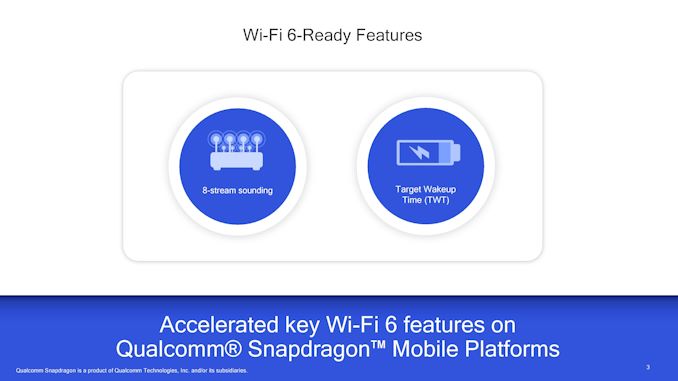
With the upcoming ratification of the Wi-Fi 6 (802.11ax) standard expected in August, a number of companies are gearing up with Wi-Fi 6 ‘ready’ routers and end-points to get the jump on the market. The idea is that the standard won’t change much between now and full ratification, and most companies developing chipsets expect to sail through without issues – the only difference between the companies will be on the ‘optional’ portions of the specifciations. With that, as we saw at Qualcomm’s Tech Day at the end of 2018, the company will be pushing its latest Wi-Fi 6 solutions onto the market. Today is the launch of one of the chipsets, the QCA6390, which also incorporates BlueTooth 5.1.
Qualcomm’s newest chip, built on a 14FF CMOS process, will support up to 1.8 Gbps of Wi-Fi 6 bandwidth over a combined 1024-QAM dual-band (5 GHz and 2.4 GHz simultaneous, up to 80 MHz) connection, as well as WPA3 security, enhanced BlueTooth 5.1, and additional optional features to the Wi-Fi 6 specification. Two of those optional features relate to Target Wake-Up Time, allowing devices to wake quicker and use less power doing do (up to 67% better power efficiency), and 8-stream sounding, which supports multiple devices doing high-data rate actions without network congestion. There will be additional proprietary power and performance benefits for users with Qualcomm silicon as both the host and the devices.
One of the key philosophies of Qualcomm’s wireless strategy is that WAN and WLAN are developed in tandem, rather than in isolation. As the WAN or WLAN standards improve, the other has to meet it with similar updates for performance, power, and efficiency. Qualcomm states that as we move into a 5G era, with condensed networks of users performing high-bandwidth operations simultaneously from multiple devices, technologies like 5G and Wi-Fi 6 will sustain a core part of the company’s wireless portfolio. We have already found devices that use both the recently released X55 modem, along with the new QCA6390.
Along with supporting all the mandatory features of Wi-Fi 6 as well as many of the optional features, Qualcomm is doing the same with WPA3 on the QCA6390: supporting the full suite of mandatory and optional features. This includes WPA3 Personal, WPA3 Enterprise, WPA3 Enhanced Open, and WPA3 Easy Connect, making the chipset suitable for consumer, commercial, and enterprise use cases.
On the BlueTooth 5.1 side of things, Qualcomm wanted to highlight three parts to their implementation. The first is connectivity, with the QCA6390 supporting one-to-many connections. This means that a single chip can support over 1000 devices simultaneously, rather than a 1-to-1 or 1-to-2 implementation, over a single antenna BlueTooth solution today. We were told that attaching more devices to a single control point does increase power consumption slightly, however the biggest change in power will be relative to the distance between the control and the most distant device.
On latency and quality, Qualcomm states that they can support 80ms latency for video lip sync, which equates to just over two frames of video. The new standard also includes support for a number of high quality audio codecs, although in our briefing the speaker was unable to quantify exactly which or what is new.
Qualcomm aims for the QCA6390 to be a chipset for multiple wireless markets, and sit at the top of its wireless portfolio as a Mobile and Computing connectivity SoC. This includes mobile, 2-in-1, tablets, smartphones, and even for automotive and smartwatch markets. It has a networking industry counterpart in the IPQ8074. The QCA6390 will be offered to partners as a flip chip design or as part of a module, and Qualcomm states that it has 50% or lower power consumption compared to alternative solutions currently in the market being labelled as Wi-Fi 6.
Related Reading
- Netgear Orbi Whole-Home Wi-Fi System to Adopt Qualcomm's Wi-Fi 6 802.11ax Platform
- TP-Link at CES 2019: Wallet-Friendly 802.11ax Products Announced
- HP at CES 2019: OMEN 15 Laptop Gets 240 Hz Monitor, New NVIDIA GPU, 802.11ax
- Snapdragon 855: 802.11ax-Ready / Wi-Fi 6 Demonstrations
- TP-Link Announces Archer AX6000 and AX11000 Wi-Fi 6 (802.11ax) Routers


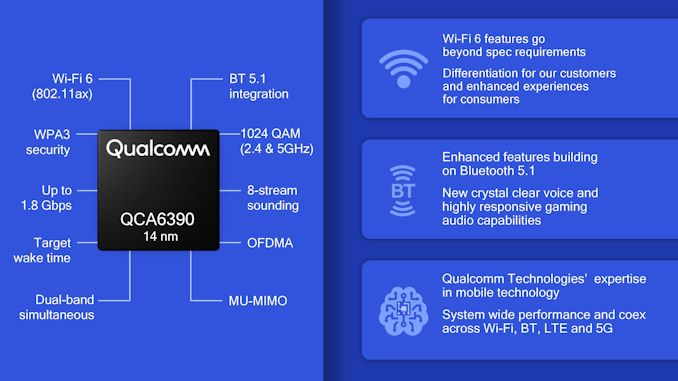
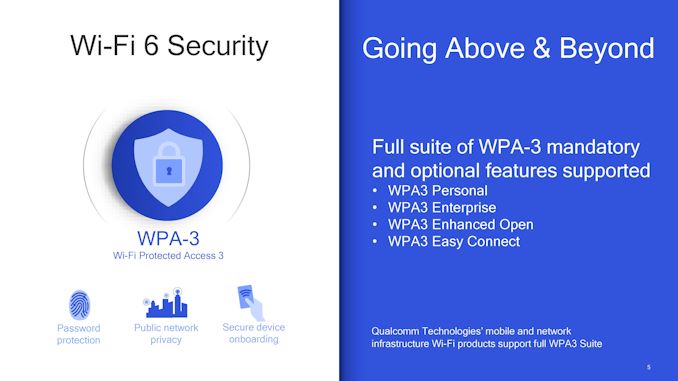
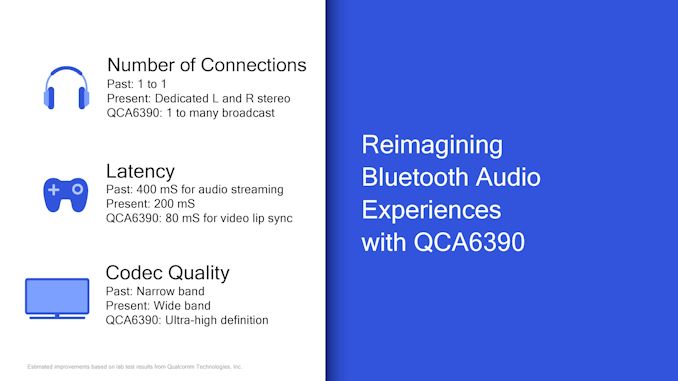
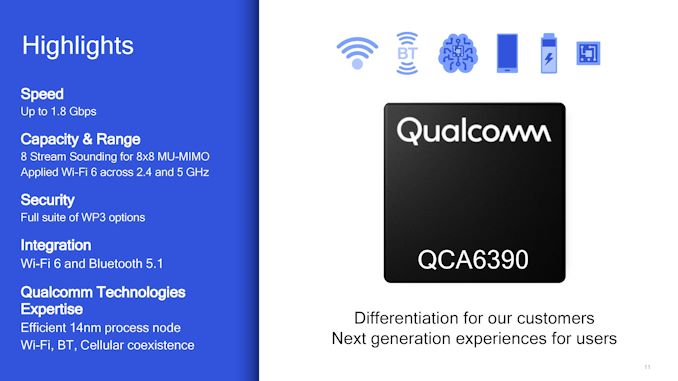














9 Comments
View All Comments
Valantar - Monday, February 25, 2019 - link
There's no capital T in Bluetooth.Valantar - Monday, February 25, 2019 - link
That might have come out sounding sharper than intended, but arbitrary mid-word capitalization is an eyesore, and there are arguments to be made for skipping it even when it's "correct" i.e. in a company name or similar. And there's definitely no reason to add it when it doesn't belong.psychobriggsy - Monday, February 25, 2019 - link
I agree entirely, ValanTar.SigmundEXactos - Monday, February 25, 2019 - link
I've always wondered. Most wifi AP's have a gigabit connection to the rest of the network. How will it ever get more than 1Gbps? Is that from one wireless device to another? Can anandtech test this somehow?Someguyperson - Monday, February 25, 2019 - link
Some routers (including mine) can use 2+ gigabit ports in tandem, effectively making a 2 Gbps connection. You really just need an additional 2+ Gbps switch at that point to make use of all that bandwidth.jordanclock - Monday, February 25, 2019 - link
WiFi is half-duplex, so the speeds are 50-60% of the theoretical maximum because of ACKs and what not. Add in other factors and a gigabit uplink is fine for now. There are only a few APs with 2.5Gb ethernet but I'm sure that number will quickly increase in the coming years. I'm fairly sure 2.5Gb also can use Cat5e cabling so most cabling could be reused.ksec - Tuesday, February 26, 2019 - link
That is why we need to push NBase-T, that is 2.5Gbps or preferably 5Gbps Ethernet using the same Cat5e / Cat6 cable. I would like router with four 5Gbps Port, with a maximum total bandwidth of 10Gbps. I don't need 5Gbps all the time, but I when I need it I want one of those port to be able to support it.andy o - Monday, February 25, 2019 - link
So to be clear, multiple BT connections is not due to BT 5.1, but a feature of this particular chipset, right? I feel like stuff like this needs to be spelled out since when Samsung came out with dual audio everyone thought that was a feature of BT 5 when it was just a Samsung feature. Likewise, lots of people currently believe that BT 5 enhances range and throughput for audio, when it only does for BT LE connections which audio is not. This was due to tech publications and prominent youtubers misunderstanding the BT SIG press release and not doing any independent research or tests whatsoever and just parroting each other. Shutout to Gary Sims at Android Authority for being pretty much the only one to get it right,of the sites that specialize in mobile tech.varase - Friday, October 18, 2019 - link
I sure hope there's no Qualcomm IP in the standard, or if there is they're not doing a "percentage of the list price of the device" like they do for cellular modems.I was suspicious when I tried pricing out the new Orbis with wifi 6.